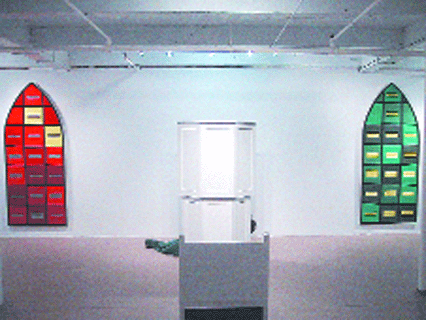Thinking art for apostle and apostate alike
Trying to access the impact of institutions on individuals, Eric Heist’s installation “Interfaith Center” tackles the heady subject of religion. In a mock Church-like setting, small pews, stained glass windows, and a pulpit with wigged mannequin hiding beneath provide the setting for the investigation. The crude construction paper windows and simple materials both trigger and remove some of the solemnity and reverence of a religious setting. A video in the adjacent room squeals with religious zeal and completes the atmosphere.
The “stained glass windows” are made of colored construction paper. In the center of each panel are simple typewritten quotes. Once these texts come into focus things get interesting, the volume is turned up, and the pressure mounts. The windows are silently screaming at each other in their thematically arranged colors.
The red window presents the quotes of extremists, which include Al Qaeda, cult leaders, and extreme Christians. One of the quotes from this window reads,”Christians tend to be opposed to violence. Some oppose capital punishment, But there is nothing in the scripture to support this view. Violence is amoral—its moral content is determined by the purpose of the violent act.” Michael Bray, antiabortion extremist.
Another quote states, “The men in paradise have sexual relations not only with the black eyed but also with the serving boys. A believer’s penis is eternally erect.” Muhammad Galal Al-Kushk, Author and reporter. The sources of the quotes are listed in an available handout.
The green window presents the testimonials of believers. One reads, “I have spent a lot of time thinking about death. It is up close and personal. Life is really a blink. We are all very very vulnerable. I want to lead a more mindful life.” Hedges.
The only round rose window is blue and presents the quotes of unifiers, including Christ, Gandhi, Martin Luther King, Jr., and Mohammed. One quote here reads, “The weak can never forgive. Forgiveness is the attribute of the strong.”
The statements of critics of religion Darwin, Ben Franklin, Voltaire, and Marx are included in the gray window. Aleister Crowley states, “If one takes the Bible seriously one would go mad. But to take the Bible seriously one must be already mad.”
Sculptural elements in the center of this written information include an overly dramatic blanked figure cowering beneath a pulpit, titled “Artist Talk, 2005,” as well as simple, single church pews scattered about the installation. These seats also serve as receptacles of debris and refer to Christ’s writings about his omnipresence in everyday materials.
In the adjacent room a video from the Church Channel shows an emotionally charged televangelist in front of a huge crowd telling a story and repeating, “Are you following me? Are you following me! We have the answer.”
This ambitious exhibition begs the question with its panorama of viewpoints.
gaycitynews.com


































